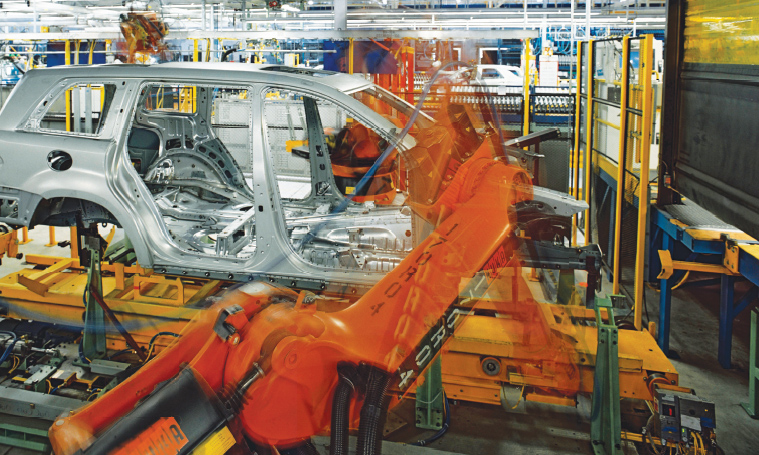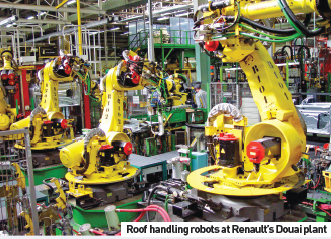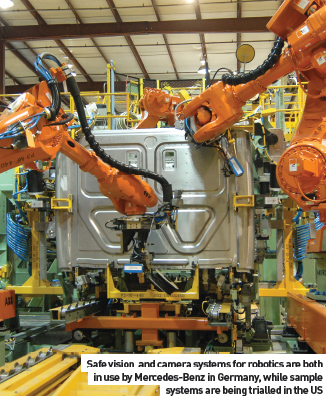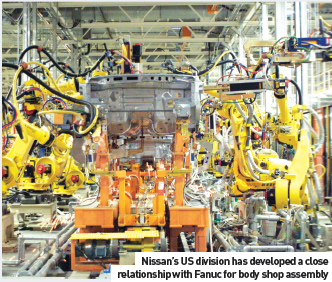
OEMs and robotics suppliers are collaborating closely on user-friendly solutions to the production process
The automotive sector, with its seemingly neverending quest for greater productivity, has proved to be a fertile breeding ground for robotic innovation. The body shop in particular has a dizzying array of robots performing a variety of tasks. This abundance isn’t reflected in a levelling off of sales however; growth is continuing apace, fuelled by lower costs and greater versatility.
According to the Robotic Industries Association (RIA), sales to automotive manufacturing companies and their suppliers are fuelling the growth in North America. Ake Lindqvist of ABB and chairman of RIA’s statistics committee noted that automotive-related sales were up 58 per cent in units and 15 per cent in revenue in the last quarter of 2007. “While the cyclical purchases of the automotive industry are responsible for the majority of the gains this year, we are heartened to see that sales to non-automotive industries also posted gains of 2 per cent in units and 31 per cent in revenue through September,” Lindqvist added. Fully-integrated vision systems are on the path to being a standard feature in automotive robots. They are not a new innovation but, just like the robots themselves, are gaining greater penetration because of their reliability and tumbling costs. Rick Youngblood, Plant Manager of Truck Trim and Chassis at Nissan, North America, says: “There are a lot of quality enhancements possible with a vision system, such as the application of mastic and sealant, and being able to pinpoint precisely the application area; that’s a primary area where we use it.
“Laser measuring for body accuracy has also been greatly enhanced in the last couple of years. At one time you basically took a unit out of the system to a layout machine and either manually or (later on) automatically laid it out. We have got that capability inline and can do it on every unit that we build in a lot of cases.” Roberta Nelson Shea, General Manager at Pilz Automation, speaks of developments in vision systems that will become available in 2008. “Safe vision and camera systems for robotics are both in use by Mercedes-Benz in Germany and sample systems in the US are being tried out.”
Gary Zywiol, of Fanuc, sees the same thing happening. “Fanuc shipped 50 per cent more robots with vision in 2007 than in 2006 and we expect that to continue in 2008. In the past five years our robotic vision shipments have increased by 400 per cent, so vision is growing faster than the rate of robotic growth.” More robots are vision-ready, which allows users to simply plug in a camera. Integrated vision is a handy feature for end-users new to robotics that might not see the need for vision initially, but could as their manufacturing requirements change.
 New trends in robotics
New trends in robotics
According to Pascal Milliot, General Manager, Body Assembly Engineering Department at Renault, there are currently three major trends in robotics. First there is the growing use of collaborative robots; second is the increase or the extension of robot ranges; and thirdly, there is the continuing price decrease of operational and fully-installed robots. “By ‘collaborative robots’, we mean safe robots that can interact with operators,” Milliot explains. “They are endowed with software full locks and will be associated with safety vision systems for the human environment. This trend is currently being developed and validated in response to legal issues. This major step forward will allow us to gain time, flexibility and, therefore, money.”
Collaboration is a theme that rings true at Toyota Motor Manufacturing Kentucky. “While it is important to maintain the human factor to ensure process quality, the cooperation of robotics and humans has allowed our department to replace operators faced with ergonomically-challenging processes and conveyance. This improves the long term health and safety of our workers,” Sutton Davis, Manager of Body Weld and Manufacture, explains. “This is a welcome change that allows the operator to focus more on the quality of the area they work in, thus ensuring that their product is defect-free before shipping to their customer.
Increases and decreases
The second trend of expansion is explained by Milliott as, “an increase in the number of models and an increase in robot load because of multi-tooling applications and diversity that enables them to adapt them to various industrial contexts.” Concerning the third trend, that of on-going price decrease, Milliot says it is important to remember that “if a laboratory robot costs €100, a robot that is functional in a plant is worth €300, once we have added the associated tools and taken into consideration the real industrial environment. Suppliers work on reducing the cost of installed robots, focusing in particular on terminal axes and the robots’ immediate environment (various actuators and handling grips).
“In the 1970s, robots were hydraulic-based and actuators were either pneumatic or mechanical. Now, robots are electric and actuators are increasingly programmable (and therefore, increasingly intelligent). As a result they are likely to be more flexible and able to work on a variety of products, on the same line.”
This is an observation echoed by Davis, but he adds to the list of current trends. “The current trend in robotics and automation is for size reduction and increased efficiency for both the operator and designer,” he says. “With a smaller platform, lines can be compressed, saving valuable floor space. Robotic makers are also standardising to universal teach pendants that allow the end user to utilise teaching knowledge across multiple models and manufacturers.”
User-friendly robots
Over in Tennessee, at the Nissan Smyrna facility, John Davenport, Department Manager of Body Assembly, cites increased user friendliness as a key area of growth. “There are real improvements in the area of user friendliness and the ability to integrate the robot with other pieces of equipment that had not been there in the past.
“The process that we use for teaching and troubleshooting with the robots has also greatly improved. It has got a lot of features with it now; it is just a whole lot more user friendly. The robots aren’t what they used to be. “We also have the capability to control a lot of other pieces of equipment through the robot itself, instead of having to have so many different controls interlocked together; the robot itself can control other features that it wasn’t able to. The robots are becoming capable of integrating with the other stuff which is wired straight into the robot; we let the robot control it itself.” That user-friendliness has allowed carmakers to upgrade their robot diagnostic systems. “In a lot of applications we have a much greater control over the diagnostics and troubleshooting of robots because of the user friendliness of the integration,” Youngblood explains. “If a robot is in trouble or experiencing some difficulty in its program, it will send an e-mail to us to tell us to check it. It gives us an indication that something is wrong.”
 Speed, accuracy and quality
Speed, accuracy and quality
At Toyota Kentucky, robots are used in many of the traditional functions. including MIG welding, spot welding, stud and nut welding, sealer application, material handling and even quality inspections. With the increased reliability of vision systems, Davis says Toyota is now able to verify part quality and placement to ensure the quality of the vehicle. “Changing from pneumatic weld guns to servo driven is just another example of a method that allows better accuracy and faster production in our processes,” he continues. “We currently use robotics to accomplish many activities that were normally either ergonomically unsafe or activities that created a less than desirable environment relating to plant safety. A good example would be automating conveyance so that we are able to reduce the number of tuggers and fork lift trucks moving throughout our plant.”
“I agree that the body shop is almost as automated as it can be,” Davenport concedes. “We are using robots because of the new types of safety features they now incorporate. The robots are a whole lot safer now than they were in the past and we are able to do more with them and have them in closer proximity to where the operators are. I think that we are using the robots a whole lot more now in material handling than we have in years past, which is an ergonomic improvement for our technicians.
“We do not have to put a technician in a place where they could hurt themselves by picking up something repeatedly or something that weighs more than what would be safe. A robot can do it much quicker and it is reliable,” he adds. Even with automation at an all-time high, OEMs are able to find niche operations that, to date, have been the domain of human operatives. One such example at Nissan involves a couple of welding robots that have been fitted with brushes to remove excess weld expulsion from the body side panels. “We are also working on de-burring some of the weld flanges inside the door openings,” says Youngblood.
Robot assembly
Although robot use is at its highest in body and paint shops, assembly is also increasing its use of them. “Currently in trim and chassis I have six robots in operation and another cell that will go in at the beginning of April this year,” says Nissan’s Davenport. “It is actually going to be doing some welding and material handling on rear axles. It is replacing a manual weld operation and two guys with an air-assisted hoist.”
Davenport feels that robots will increasingly have a role to play in assembly, particularly with the growth of affordable vision systems. “I don’t know that assembly is best kept labour intensive, but at this point there are still some functions the human eye performs that vision systems cannot replace,” he says. “I think we are always going to have to check the quality of a part that is installed, particularly from a trim perspective. I think that there are several opportunities to add robotics operations to the assembly process. Among the things we are looking at is using robots to handle the larger units during assembly.”
In the assembly hall at Nissan Kentucky, the company recently integrated robotics coupled with 3D vision systems to load floorplans. “This capability detects any variance in stacking of parts and shifting that may occur in transit to allow exact placement into the cell, thus eliminating downtime to the process for mis-sets and eliminating the ergonomic strain to the team member loading the process.”
Production flexibility
Throughout the industry flexibility is the key driver and, while in the past robot cells had the reputation of being inflexible, they now support extremely flexible processes. “With the new datum-style robots, we are able to manufacture many different styles of vehicles and perform running changes on current or new models with little impact to production capability,” Davis explains. “In other words, automation allows us a seamless transition from one model to another.”
For Youngblood, the capability and functionality of the current breed of robots is what drives flexibility. “They have the capability to run numerous programmes and make some of the decisions that probably ten or 15 years ago you needed a production or maintenance operator for,” he explains. This is a theme that Davenport is happy to expand on. “The robot cells themselves are very flexible now. We run multiple models down the same line and through the same cell. We are not only doing welding, we are doing spot welding and we are even doing laser welding with the robots. We are doing sealing and material handling and we are also using them as a check for dimensional accuracy with vision system. “A lot of robots in the past had to be used for one or the other, but now we actually have gun changers or hand changers. These can weld and then change to a material handling hand or to a sealer nozzle, or something else. It can do multiple applications on the same vehicle in the cell. “We can run different models back to back. We can run a truck and then an Explorer and then a Pathfinder back to back and it knows exactly what model it is and all the features of that vehicle. So it knows what to do to that vehicle,” he adds.
Robotic relationships
Unlike other automation equipment, which is often purchased on price and specification, automotive OEMs look to develop relationships with robot suppliers. It is not uncommon to see entire factories featuring ABB, Motoman, Fanuc or Comau. For Nissan in the US, that company is Fanuc. “Right now, everything that we have in the body shop, with just a few excecptions, are all Fanuc,” Davenport confirms. “We stick to Fanuc so that we have consistency with training. We pick the type of robot depending on the weight that we are trying to pick up, whether it be a welding gun or a hand, the reach that we have to do; a lot of it depends on what the function is.” “Some of the robots are limited in their capability of what they are able to carry on the end of the arm of the robot,” Youngblood continues. “So in some cases you need a larger robot and in other cases a smaller one. It is just a matter of how big its payload is to what we select it for. “Because of the variety of applications we are using, we give feedback to our robot vendor which effectively says, ‘if you guys can tweak your robot to this capability then that would help us’. At the same time, we are asking the robot manufacturer to suggest the best model for the environment or application. So I think that true team concept is selecting a business partner who knows the day-to-day environment that we work in, rather than somebody who just drops robots off at your back door.”
The robotic developments OEMs are seeking are obviously geared towards increasing productivity. “We are always looking for ways to make improvements and be more efficient and more productive,” Davenport says. “We are looking to integrate other pieces of equipment over which the robot can have control and improve the user friendliness which allows a robot to do more for us. One of the big things that we are working on now is diagnostics on the robot – not waiting until the robot breaks before finding out that there is a problem. We have diagnostics built into the software of the robot and if it sees itself having a problem, it will warn us that it is happening. Then we can take care of the issue at our convenience rather than during down time.”
Robotics is playing an important role among Tier One suppliers. At one automotive powertrain manufacturer, which had been producing automotive transmissions the same way for many years, operatives were searching for a more efficient means of production to improve their assembly process. The manufacturer had been using a robot to unload parts from its assembly line when production was backed up downstream. The robot’s job was to gather parts from the line for storage and place them into a temporary bin.
The overall process, however, was not fully automated because once the assembly line was back in full motion, plant workers had to manually place the parts back onto the line. The company decided that a fully automated process would help improve productivity. The robot was already being used to remove parts from the assembly line during back ups. The goal was to robotically put the parts back on the line once it was back in motion. The challenge was part placement – once the parts were removed from the line they were sitting loosely in a bin. Parts in the bin shifted as the bin was transported away during line backups, and again when the bin was returned to the line as production resumed.
To make the new process a success, the robot was required to accurately locate each part, pick it up and put it back on the line. To increase the new functionality, Fanuc Robotics reprogrammed its customer’s R-2000iA/125L robot, adding handling tool software and a three-dimensional vision system. Together, these tools enabled the robot to determine part location and orientation in the bin so the parts were properly placed back on the line. The software also prevented the robot from colliding with the bin wall. If the system determined that a collision is likely, the robot pulled the part away from the wall and moved it to a more favourable position. Once the part was correctly repositioned, the robot picked up the part and placed it back on the assembly line for further processing. After all parts from a layer had been put back on the line, the robot picked up the “slip sheet” from the parts bin and placed it in a predetermined location. The robot then repeated the vision picking process on the next layer of parts and continued until all layers were emptied.


































